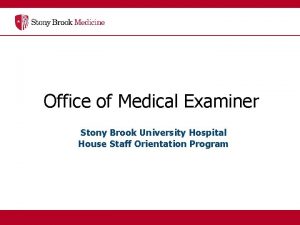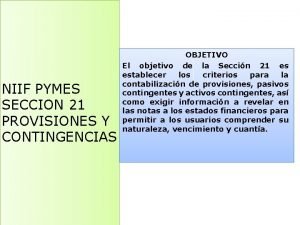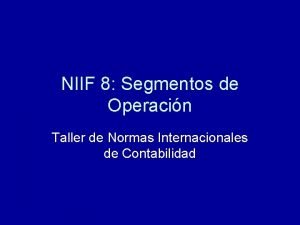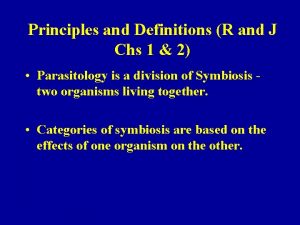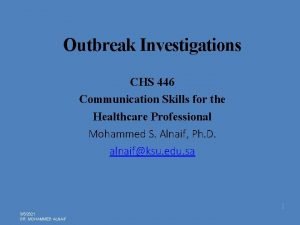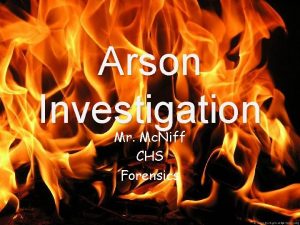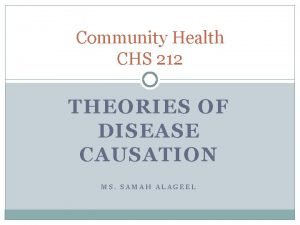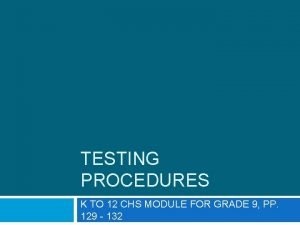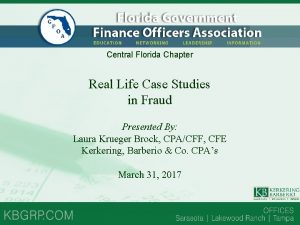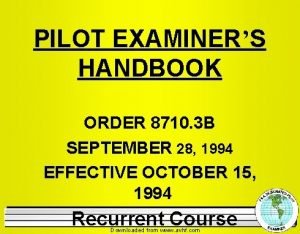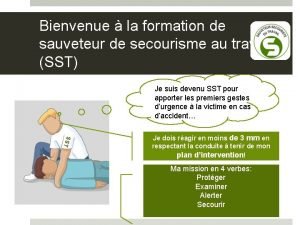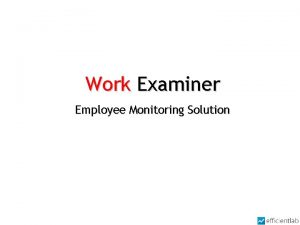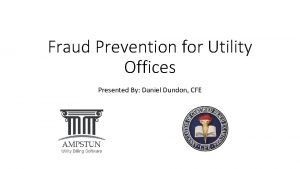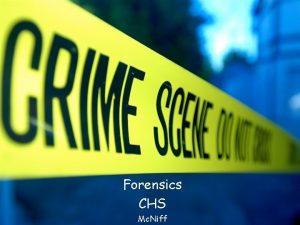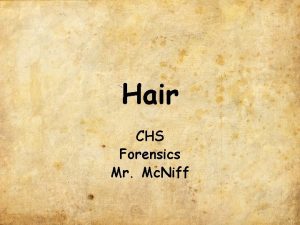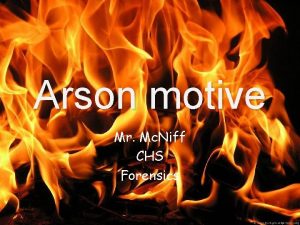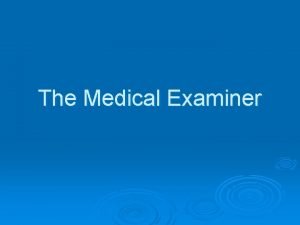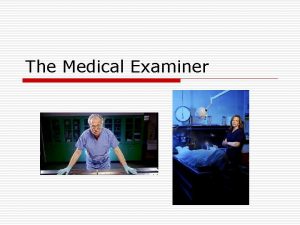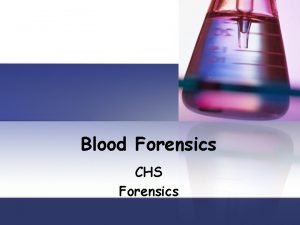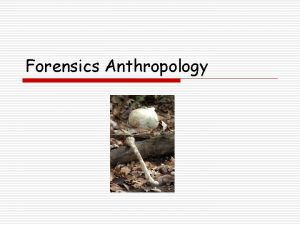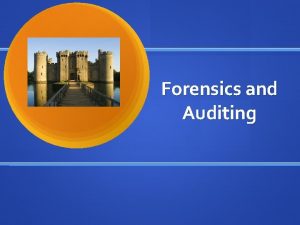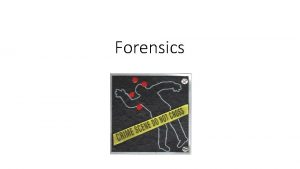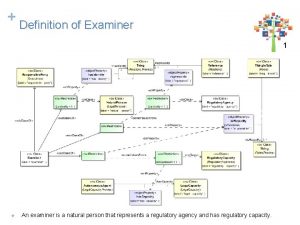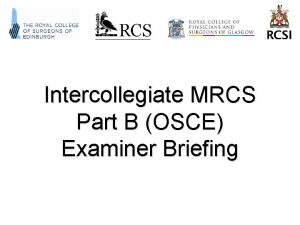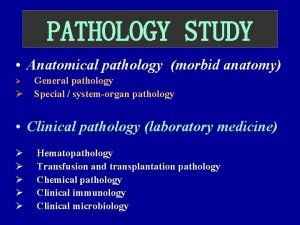Pathology Medical Examiner Mr Mc Niff CHS Forensics





































- Slides: 37

Pathology Medical Examiner Mr. Mc. Niff CHS Forensics


Who are Medical Examiners A doctor who performs an autopsy when someone dies an accidental or violent death. They determine the cause of death as well as time of death.

forensic pathologist A forensic pathologist is a physician who has received special training in pathology and forensic pathology. Their training takes approximately six years after graduating from medical school.

Medical Examiner vs. Coroner A medical examiner is always a medical doctor whereas it is not necessary for a coroner to be a medical doctor. A medical examiner is appointed while a coroner is usually elected.

Medical Examiner vs. Coroner A medical examiner gives objective information on the circumstances of a victim’s death. A coroner must give subjective opinions based on evidence found surrounding a victim and their death. Coroners usually have legal powers such as subpoena powers.

Classification In a forensic autopsy, death is placed into five different categories. Natural Accident Homicide Suicide Unknown

Natural Death by natural cause is a term used by coroners to describe the death of someone by occurring disease process, or is not apparent given medical history or circumstances. The majority of natural death is caused by old age. Other causes of natural death are heart disease, stroke, gentic disorders, etc.

Accidental Death Accidental death is a death that is often caused by mistake or in a freak occurrence. Deaths are not planned yet can be explained by surrounding circumstances.

Homicidal Death The term ‘homicide’ refers to the act of killing another person. There are different types of homicide. Infanticide - Killing of an infant Fratricide - Killing of one's brother; in a military context, killing of a friendly combatant Sororicide - Killing of one's sister Parricide - Killing of one's parents Patricide - Killing of one's father

Homicidal Death Mariticide - Killing of one's spouse Uxoricide - Killing of one's wife Filicide - Killing of one's child Regicide - Killing of a monarch. Genocide - Killing of a national, ethnic, racial or religious group Homicide is often the most investigated death, therefore making it the most autopsied.

Suicidal Death The act of ending ones own life. These autopsies often easily identify source, cause, and other factors of the death. Suicide is often identified in the forensic autopsy as a cause of toxic, firearms, blunt force trauma, etc.

Unknown Death In some jurisdictions, the Undetermined category may include deaths in absentia, such as deaths at sea and missing persons declared dead in a court of law; in others, such deaths are classified under "Other“.

laws Although State laws vary in specific requirements, deaths that typically require investigation are those due to unusual or suspicious circumstances, violence (accident, suicide, or homicide), those due to natural disease processes when the death occurred suddenly and without warning.

Medical Examiner Human remains are treated as a separate and unique type of forensic evidence. An autopsy of the remains is completed to determine the cause and manner of any death that is violent, unusual or untimely.

Medical Examiner A forensic pathologist will examine the human remains (post-mortem examination) and consider death scene findings. The medical history of the individual may also be reviewed to help determine if the death was natural, accidental or criminal.

External Investigation The body must be measured and weighed and placed on an autopsy table prior to making the Y-cut. A general description of the body is made before any further examinations are done. All identifying features are noted including: Race Sex Hair color and length

External Investigation identifying features cont. Eye color Approximate age Any identifying features (scars, tattoos, birthmarks, etc. ) Any wounds inflicted on the outside of the body (burns, ligature marks, stab wounds, bullet wounds) Photograph the body

Identification of the deceased If the Identity of the deceased is unknown the M. E. needs to ID the body. The condition of the body due to scavengers or decomposition can make a visual ID impossible.

Identification of the deceased Three common methods used to ID a unknown victim: DNA (from tissue or bone) Dental records Fingerprints due to decomposition some fingers need to injected with liquid to make the print usable.

Internal Investigation The body is opened using a Y-shaped incision from shoulders to mid-chest and down to the pubic region.

Internal Investigation If the head is to be opened, the pathologist makes a second incision across the head, joining the bony prominences just below and behind the ears.

Internal Investigation

Types of Evidence Injuries: Describe injuries • Location • Type – Blunt force – Laceration – Cut – Gun shot • Severity • Distinguishing markings

Types of Evidence Injury patterns: Describe patterns Associated with weapons, objects, details Blood flow patterns • Note • Photograph Directionality patterns • Injury • Blood spatter

Mechanical asphyxiation including strangulation, can be marked by the appearance of petechial hemorrhages on the conjunctiva, as shown here.

Mechanical asphyxia Finding ligature marks on the neck, hyoid bone fracture, and/or soft tissue hemorrhages in neck and larynx may help to determine the mechanism of injury.

Hanging Inspect the knot Type / How tied • Running/fixed Point of suspension How affixed Distance from ground/floor Evidence of previous suspensions Autoerotic Position of body Livor mortis Platform

Stabbing Wounds Location of wounds Defense wounds Attempt to determine the type of weapon used Injury patterns Blood spatterns Location of initial injury versus location of body blood stains in a separate area from the location of the body

Gunshot wound Location of wounds Type of wound Powder marks, stippling Weapon Caliber Ownership Secondary impact points if the bullet exited the body Directionality consistent with the known details

Falls Reason for the fall Intentional (suicide) Slip (accidental) Pushed (homicide) Details of fall Point from which the decedent fell Distance to point of impact Vertically from point of elevation

Blunt force trauma How injuries may have occurred Injuries and injury patterns Consistent with any surrounding objects Object at the scene that may have caused the injuries

Drug related Drugs or paraphernalia Location in reference to death scene Possible type of drugs involved Collection and preservation Evidence on the body that may indicate drug use • Injection sites • Indications of inhalation, or huffing

Lacerations

Exsanguination is the extensive loss of blood due to internal or external hemorrhage.

Pictures http: //useucom. wordpress. com/2009/12/ http: //www. tattoosymbol. com/symbols/biohazard-tattoo. html http: //radiology. uchc. edu/e. Atlas/Skin/849. htm http: //radiology. uchc. edu/e. Atlas/Skin/925 b. htm http: //www. pathguy. com http: //en. wikipedia. org/wiki/File: Captain_Awesome. jpg http: //www. autopsytv. com/component/option, com_tag/Itemid, 0/tag, autopsy/ http: //episac. deviantart. com/art/eye-drawing-93361267? q=sort%3 Atime+favby%3 AKassx. Courage&qo=1 http: //www. ultrapaul. com/wp-content/uploads/2010/04/Shatner. TA. jpg http: //www. kenniederbaumer. com/fx/index. html http: //zoestrauss. blogspot. com/2008_01_01_archive. html http: //www. bloguin. com/articles/football/Page-35. html http: //onemansblog. com/2007/09/05/wheres-osha-when-you-need-em/ http: //games. adultswim. com/five-minutes-to-kill-yourself-reloaded-adventure-online-game. html

Refrences Thompson, Darrell. "Forensic Death Scene Investigation. " Tarrant County. Web. Rahman, Mahmuda. "The Medical Examiner/ Forensic Pathologist. " Web. Kacher, Emie. "A Day in the Life of a Forensic Pathology. “ USA. CDC. Department of Health and Human Services. Medical Examiners and Coroners Handbook on Death Registration and Fetal Death Reporting. By Donna L. Hoyert, Ph. D and Arialdi M. Minino. Edition ed. Vol. 2003. Print
 The three little pigs nif nuf naf
The three little pigs nif nuf naf Somatic death
Somatic death Canadian coroner and medical examiner database
Canadian coroner and medical examiner database Medical examiner vs coroner
Medical examiner vs coroner Medical examiner
Medical examiner Dr stephen evans ottawa
Dr stephen evans ottawa Dr kevin horn medical examiner
Dr kevin horn medical examiner North carolina medical examiner toxicology
North carolina medical examiner toxicology Medical examiner vs coroner
Medical examiner vs coroner Sección 20 niif para pymes
Sección 20 niif para pymes Niff
Niff Ejercicios resueltos de provisiones y contingencias
Ejercicios resueltos de provisiones y contingencias El patrimonio
El patrimonio Niif 8 segmentos de operación ejemplos
Niif 8 segmentos de operación ejemplos Pathology lectures for medical students
Pathology lectures for medical students Chs hcpss
Chs hcpss Chs statistics
Chs statistics J'chs 1
J'chs 1 Baseball parent meeting agenda
Baseball parent meeting agenda Budowa logiczna dysku twardego
Budowa logiczna dysku twardego St. robert catholic high school
St. robert catholic high school Chs investigations
Chs investigations Creative house scaffolding
Creative house scaffolding Chs investigations
Chs investigations Example of chs theories
Example of chs theories Cms.edf.school
Cms.edf.school Chs vs ibs
Chs vs ibs Chs module
Chs module Certified fraud examiner
Certified fraud examiner Attendance certificate for external examiner
Attendance certificate for external examiner Edna the examiner
Edna the examiner Kansas assessment examiner's manual
Kansas assessment examiner's manual Rita crundwell american greed
Rita crundwell american greed Eduqas examiner vacancies
Eduqas examiner vacancies Flight examiners handbook
Flight examiners handbook 4 verbes d'action du sst
4 verbes d'action du sst Work examiner review
Work examiner review Certified fraud examiner
Certified fraud examiner




